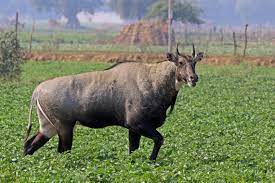Nilgai
2021 DEC 29
Preliminary >
Environment and Ecology > Species extinction & protection > Species in news

Why in news?
- Bihar plans to sterilise the nilgais instead of culling them to control their population in view of repeated demand by farmers to save their crops
About Nilgai:
- It is also called bluebuck
- It is the largest of all Asian antelopes and is one of the most commonly seen wild animals in all of India
- The nilgai is indigenous to the Indian subcontinent.
- It is the only one of the four Indian antelopes that is still abundant.
- Nilgai prefer areas with short bushes and scattered trees in scrub forests and grassy plains. It is common in agricultural land, but rarely in dense forest.
- IUCN Status : Least Concern
- Nilgai, in India, comes under Schedule III of the Wildlife Protection Act, 1972
Declaring as vermins
- The governments of Bihar, Maharashtra and Uttarakhand have urged the Government of India to declare the nilgai as vermin; the proposal has been implemented in Bihar, where nilgai can now be hunted to minimise the damages incurred by locals.
- As per Section 62 of the Wild Life Protection Act, the Central Government may, by notification, declare any wild animal other than those specified in Schedule I and Part II of Schedule II to be vermin for any area and for a specific period.
PRACTICE QUESTION:
With reference to ‘Nilgai’, consider the following statements:
1. They are commonly found in dense forests
2. They are protected under Schedule III of the Wildlife Protection Act, 1972
Which of the statements given above is/are correct?
(a) 1 only
(b) 2 only
(c) Both 1 and 2
(d) Neither 1 nor 2
Answer
